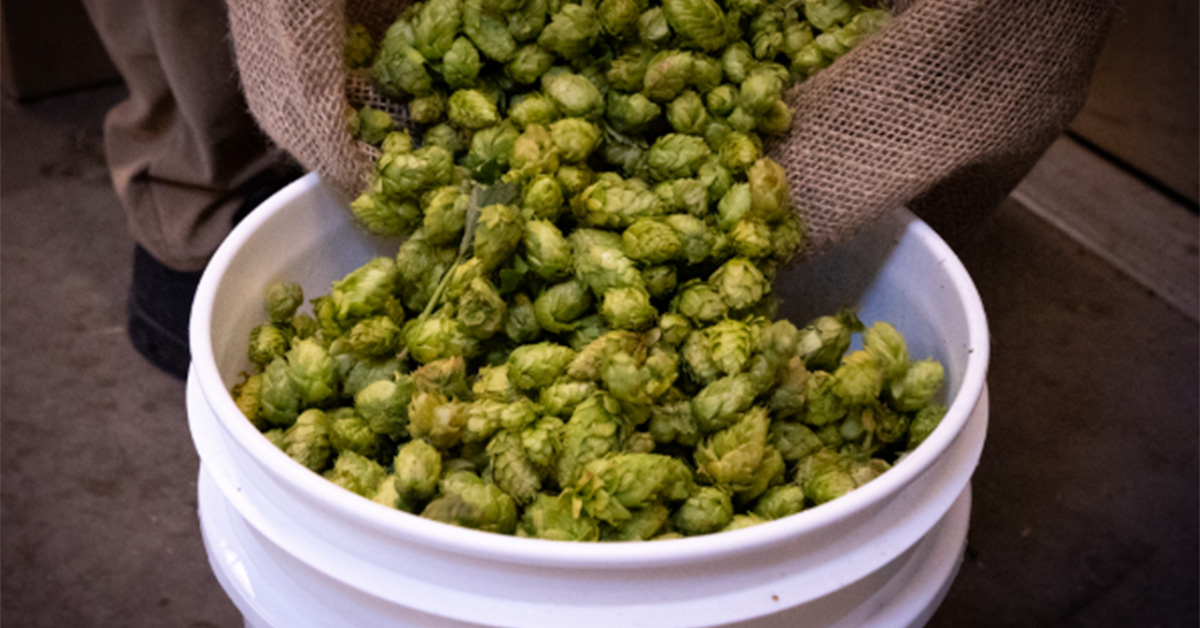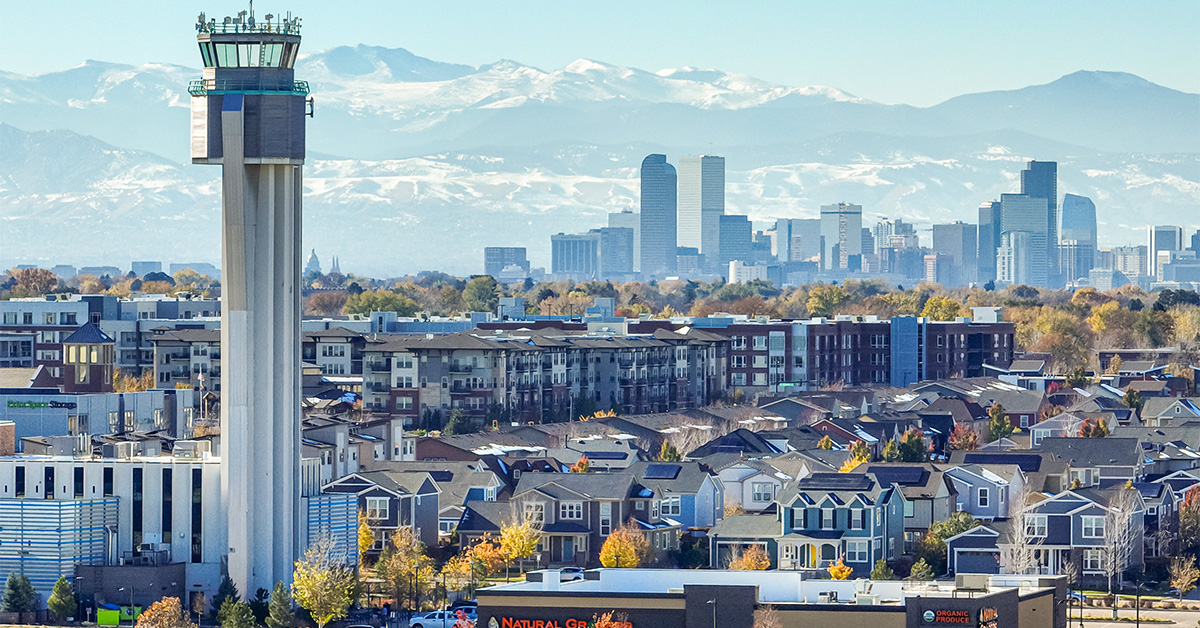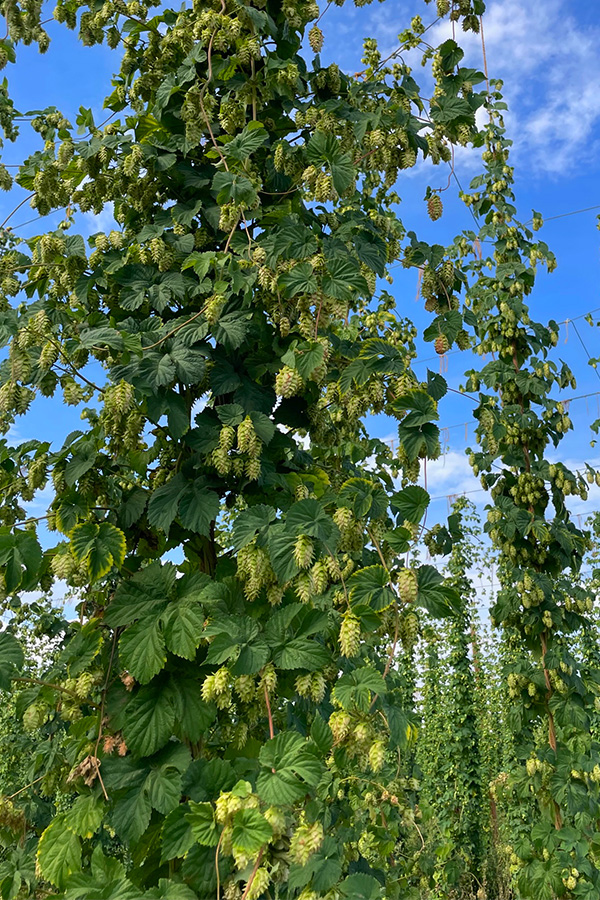It’s 6:32 a.m. when I see the latest email from Eric Serani, cofounder and president of Denver-based FlyteCo Tower brewery and bar: “Ugh, looks like the clouds aren’t going away.” I’m already halfway from Denver to Erie Municipal Airport, where Serani had been planning to fly his four-seater RV-10 to Billy Goat Hop Farm in Montrose, Colo., for a fresh hop pickup.
FlyteCo has been making this trip—typically mid- to late August—since the brewery opened in 2019. Plenty of beer writers count a ride-along on their bucket lists, and I’d been eagerly anticipating the experience for months. But the weather doesn’t much care about fresh hop beers, pilots’ passion projects, or journalists’ dreams. As the hop flight gets postponed from a Monday to a Wednesday and then again, it becomes clear just how little about this endeavor is under Serani or any mere mortal’s control—and how getting to make this flight and subsequent beer is like catching lightning in a bottle.
“It’s always so last minute,” Serani says. “The harvest, they don’t know when that’s going to be until a few weeks ahead of time. The weather for the flight, we don’t know for sure until the day of.” Once both the harvest and weather patterns prove willing to play along, Serani has to remain in constant communication throughout the journey with the FlyteCo team back at the brewhouse. “They’re getting the beer ready for us to get back and get the hops right in. Every time we’ve been able to make this beer, it’s a miracle.”
The miracle has had a good track record. After six consecutive years, 2025 is the first time Serani isn’t sure if they’ll be able to make the flight at all. If he can’t fly to Billy Goat by the end of the week, he says, they’ll just have to get the hops shipped overnight.

Hop is My Co-Pilot Fresh Hop IPA is a “difficult beer to make,” Serani acknowledges, and in the era of hop pellets and extracts, navigating the challenging flight path over the Rocky Mountains isn’t exactly the most efficient way to get hops. But, says Serani, “the entire FlyteCo brand is about aviation, about inspiring people to push their limits and do something they don’t think they can do.” He thinks of his own path to getting his pilot’s license, how tough the going could get, and how the people who believed in him saw him through. “We want to do that for other people, whatever we can inspire them to do.” Plus, he adds, this excursion helps him and any pilots who come along keep their skills sharp.
“It’s just as much about community, too,” Serani notes. “It’s not often we can get together and fly out unless we have this common mission. And then we get a great beer out of it.”
Learning to Fly
On the cloudy Wednesday that this year’s hop flight had been pushed to, just a few of us—significantly down from the eight planes’ worth of hop-motivated pilots and passengers originally signed on—showed up to Erie for what would essentially become a post-mortem for the day’s flight of fancy. One member of the group is Serani’s father, Scott, which is how I learned that building and flying planes is a treasured family tradition generations strong. As Scott Serani points out photos, newspaper clippings, and plane pieces tacked to the wall of the family’s hangar and father and son share stories, I learn just how deep aviation’s roots run for Eric Serani and FlyteCo.
Serani grew up in Broomfield, Colo., about a 20-minute drive from Erie Municipal Airport. When he was just three years old, his grandfather took him up in his own 1946 kit plane during the toddler’s visit to Chicago. By the time Serani was five, his grandfather had moved to Colorado, where he could closely foster his grandson’s love of flying. His friend, a flight instructor, started teaching Serani to fly in earnest when Serani was 13. Sixteen is the earliest one can legally fly a plane alone, which Serani did; at 17, he got his full license allowing him to take passengers up with him. Between those two milestones, his grandfather passed away. The members of the EAA—Experimental Aircraft Association—chapter he and his grandfather belonged to rallied around Serani, realizing he’d lost his biggest supporter, and also that he needed to train in a more contemporary plane. They raised enough to give Serani a scholarship to hone his craft and become certified at Erie’s airport.
From that moment on, Serani wanted to pay that community support forward. He joined the EAA’s Young Eagles program, which gets kids between the ages of eight and 17 up for their first flights to spark their interest in aviation. And yes, that means Serani was sometimes flying kids older than him.
“One time, one of the kids’ mothers came over to me and asked if I was excited to go up for my first flight. I told her, ‘Ma’am, I’m the pilot,’” Serani says with a chuckle. Serani has continued his work with the EAA and balances running FlyteCo with a position as a flight instructor at Erie.
Dreams of a Flight-Themed Brewery Take Off
FlyteCo’s Denver location isn’t just meaningful for Serani’s personal history, but for aviation history. Today, Denver International Airport (DIA) is the third busiest in the United States and sixth in the world. Major airlines like United once had key hubs at the city’s original airport, Stapleton International Airport, which opened in 1929 and hit third place for busiest airport globally by 1961—it may have in fact grown too quickly to keep up with the traffic, as it closed in 1995 and operations transitioned to DIA. After Orville and Wilbur Wright shocked the world with the first flight in 1903 and aviation was born, it was considered impossible at high altitudes; to prove this theory wrong, French aviator Louis Paulhan became the first to fly in the Mile High City in 1910. And in 1954 in Aurora, just a few minutes’ drive from FlyteCo, Bob Stanley established the Stanley Aviation Manufacturing Plant, where he innovated upon and became one of the largest producers of airline ejection seats.

Serani learned to fly, therefore, in a part of the country that had really earned its wings, and this is fittingly where he would chase his next dream: owning a brewery. He and FlyteCo cofounder Jason Slingsby were roommates at the University of Colorado Boulder where Serani studied aerospace engineering—Slingsby went on to get his master’s degree in chemical engineering and also has a background in aviation. Serani went to work for Boeing but didn’t jibe with corporate life; meanwhile, he and Slingsby developed a homebrewing habit. After trying enough of their successful creations, friends of Serani and Slingsby declared that if the homebrewers wanted to open a brewery, they would invest.
With another cofounder, Morgan O’Sullivan, Serani and Slingsby opened FlyteCo’s original location on Denver’s Tennyson Street in February 2019 with a 15-barrel brewhouse. In 2020, an opportunity for a second location came along. After closing down in 1995, Stapleton International Airport had mostly been redeveloped, except for the air traffic control tower that had sat empty until arcade restaurant chain Punch Bowl Social took over the first three floors in 2017. But that entity shuttered by 2020, and family friends who had initially invested in FlyteCo told Serani and Slingsby they’d buy the tower if the brewery wanted to move in. After all, what could be a more serendipitous location for an aviation-themed brewery?
FlyteCo Tower opened in 2022, and in the spring of 2025, the original FlyteCo on Tennyson Street closed its doors. Copper Kettle Brewing Company, also in Denver, now brews FlyteCo’s flagship beers for them so their current 2.5-barrel system at the Tower can function as an opportunity for experimentation and smaller, more limited runs such as their Hop Is My Co-Pilot Fresh Hop IPA. The cofounders have leaned into the Tower as a massive entertainment complex with multiple bars, arcade games, bowling, billiards, mini golf, axe throwing, and more—there’s enough to do for an entire day with family or friends while enjoying FlyteCo’s beer alongside other select craft beers, wine, cocktails, non-alcoholic beverages, and a full food menu. Serani credits the something-for-everyone approachability and experiential component the Tower offers for being able to successfully run a brewery today, continuing to serve up multiple styles crafted with the same dedication to a steady crowd, and chase heady goals like fresh hop beers made possible by the power of flight.
Charting a Fresh Hop Course
When Serani broke down just how challenging the logistics of the hop flight can be as we disappointed would-be pilots and passengers lingered in the Seranis’ hangar—as if it was only in physically leaving Erie Airport that the day’s adventure would truly be canceled—I remembered a conversation I had with Morgan O’Sullivan in 2023. I was writing an explainer on fresh hop beers, and the FlyteCo cofounder had elaborated on the finicky nature of this substyle in general, let alone when you arrange your own airborne travel. Brewers must be flexible regarding what hops they’ll get as it all depends on what’s ready on which day during hops’ August-to-September harvest season. While fresh hop beers are more about the rare opportunity to brew something both truly local and uniquely ephemeral, none of them are the most efficient beer any brewer produces for the year—especially FlyteCo.

“It costs us more in fuel than it does to buy the hops, so there’s no practicality to the event whatsoever,” O’Sullivan had told me. “We do it because we’re passionate about it.”
Having interviewed dozens upon dozens of breweries at this point in my career, I am well versed in the many places where obstacles present themselves—not only in singular endeavors such as brewing with fresh hops, but in the herculean task of opening a brewery to begin with. For that reason, I’m surprised to learn that FlyteCo’s first hop flight took place the very year the brewery opened. However, the more I learn about Serani’s lifelong dedication to aviation and unlikelihood of backing down from a challenge, that element of surprise fades.
As FlyteCo’s original location opened, a friend of Serani’s who owns Bruz Beers, a Belgian-inspired brewery in Denver, was camping out at the now-closed High Wire Hops farm in Paonia, Colo. He saw a plane runway near the farm and called Serani: Wouldn’t it be something to fly his plane out here to get hops? Their interest piqued, Serani and Slingsby formulated a flight plan—175 nautical miles over the Rockies at between 11,000 and 13,000 feet in altitude, roughly a 90-minute trip for a four-seater RV-10—and then a recipe, collaborating with Bruz Beers for their first fresh hop beer.
When brewing on the 15-barrel system on Tennyson Street, the FlyteCo crew would fly back 80 to 100 pounds of hops from High Wire and later Billy Goat. Serani says the weight was never an issue, but space proved challenging—sacks of Chinook, Cascade, Nugget, or whatever was available that day were stuffed in every nook and cranny of each participating plane. Today, they get around 20 pounds of hops for their smaller brewhouse capacity, still ranging among Chinook, Cascade, and Nugget; still open to whatever Billy Goat has for them. During the flight, Slingsby preps the mash. The moment the hops touch down at Erie, they’re shuttled back to Central Park via car to get to work. Some go into the kettle for bittering while the rest go into the fermenter to dry hop the ale with their radiant aromas. It’s around this time, Serani says, about six hours after their initial departure to Billy Goat, that everyone breathes, gets a beer, and laughs about the wild adventure they just had.
Smooth Landing: FlyteCo Tower Builds on the Brewery’s Aviation Ethos
I may have not been able to experience that particular adventure this year, and as I would learn a week later, neither did the FlyteCo crew themselves. For the first year since the brewery’s launch, the weather had pushed flight plans so far that the team missed the harvest, grounding their fresh hop beer until 2026. It’s news that puts all of my own harrowing memories of delays and missed connections in perspective. I did, however, get to take in the adventure that is FlyteCo Tower, and become fully immersed in the wonder of flight for one entire day.
After all, all the arcade games in the world can’t distract from FlyteCo’s lifeblood of aviation. What other brewery can claim an in-house historian and tour guide who has taken on the mission of turning the 11-story air traffic control tower itself into a museum? I had the opportunity to take one of Sean Henson’s tours up through the tower, during which he stops on each landing to unravel the history of aviation, from Paulhan’s history-making flight to to Stapleton’s development, to the groundbreaking efforts of Marlon Green, who fought for Black pilots to be able to fly for commercial airlines, and Emily Howell Warner, a Denver native who became the first woman hired onto a permanent United States airline flight crew.
Henson is a gifted storyteller who clearly shares the passion for aviation that’s in the water—or the beer—at FlyteCo. People return to the brewery to gift him photos and memorabilia he continues to add to the tower’s collection. I learn so much, in fact, about the timeline of aviation on this tour—a history pushed along by people just like the FlyteCo Crew that dream of taking to the skies, obstacles be damned—that I find myself getting emotional about flight and the people who devote themselves to perpetually improving upon it.
Should you find yourself also tearing up on a Tower tour, give in: You’re meant to feel inspired by the power of flight at this brewery. It’s the location, it’s the aviation-themed decor, it’s Henson’s work turning the tower into an homage, it’s the beer, it’s the hop harvest flight, it’s who Serani and Slingsby are. Ten percent of FlyteCo’s profits, the brewery’s marketing manager Kaylie Maness tells me, go to aviation-fueled initiatives like the same Young Eagles program Serani has been working with since he was 17.
Even without a Hop Is My Co-Pilot IPA for 2025, the dogged determination and enduring love of aviation are core ingredients in all of FlyteCo’s beers. I’m almost sure I can taste that in the brewery’s brightly citrusy Azacca Pale Ale I sip at one of the FlyteCo Tower’s bars, surrounded by suspended model planes and aviation memorabilia, enthusiastic beer fans, and kids excited to see what game they can play next. It strikes me that the Tower captures only the good parts about an airport, like the promise of an exciting journey and the introspection it causes, making you consider what inspires you and what you might be capable of. From Serani’s intention of motivating guests to take flight or rise to whatever challenges move them, hope springs eternal. And that certainly includes hope for clear skies and fresh hops in 2026.
The post Cloudy with a Chance of Fresh Hops: How Denver’s FlyteCo Catches Lighting in a Bottle appeared first on CraftBeer.com.
